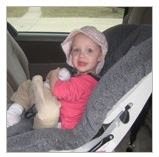 More and more families are choosing to forego the increasing expenses and hassles of air travel for the more comfortable option of driving to their timeshare rental vacations. If that’s you, please take a look at the following information on the importance of keeping your child safe in the car.
More and more families are choosing to forego the increasing expenses and hassles of air travel for the more comfortable option of driving to their timeshare rental vacations. If that’s you, please take a look at the following information on the importance of keeping your child safe in the car.
We’re Their Safety Net
With the CDC reporting that next to falls, automobile accidents are a primary cause of brain injuries, it should compel us to learn why and how. Sixty-three children died of brain injuries in 2009. A 100 percent use of the proper child restraints would have saved their lives. Moreover, brain injury doesn’t always result in death, but can result in lifelong disabilities, often requiring around-the-clock care.
Brain injury occurs in high impact with windshields, doorposts, and windows. A seat belt that can’t be tightened across a child’s entire upper body is virtually useless. These children are at high risk, and parents (and grandparents) need to realize this.
Whether or not our little ones come through an accident safely is the direct choice of how parents use child restraints. The shocker is that the survival rate of babies and toddlers is better than our pre-teens and teens, generally because we are more insistent on the younger children being properly restrained.
Seats are available for children up to the ages of 8 to 12, and it’s obvious when they can’t fit in the seat that it’s time for them to use the seat belts that equip the vehicle.
Well, you know the problem. When a child reaches five or so, they start balking at the idea of being in a “baby” seat and parents need to learn how to fight and win that battle from the get-go!
Arm Yourselves with Determination
A good reminder of this situation can be found on this blog post, summarizing an online video about child safety in vehicles. The video is a great confidence builder when it comes time to make the case to a stubborn pre-teen who’s refusing to use a seatbelt. In fact, an effective threat might be to have the child watch the video with you.
The forum panel ended up making a great point: “Safety is not negotiable.” Make it stick!
Good to Know
Recommended by the Association of American Pediatricians, April 2011: until they’re at least two, babies and toddlers belong in rear-facing seats until they get too large for their first seats.
Older children need to be using belt-positioning booster seats until they reach a height of 4 feet, 9 inches, and are between eight and twelve years old.
Finally, some forum panel members, including the woman who had convened it, mentioned that parents don’t seem to read the instructions for using the seats, so let’s say it here: READ THE INSTRUCTIONS!
Do whatever needs to be done to insure a safe and fun timeshare vacation for your family, whether you’re driving to the resort, or driving to the airport.
Guest writer Pat Hogan is an advocate for child safety and is associated with FloridaBrainInjuryLaw.com in Tampa, FL.
(Photo credit – healthychildren.org)